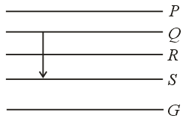EASY
JEE Advanced
IMPORTANT
Earn 100
In the orbit, the energy of an electron for hydrogen atom. The energy required to take the electron from the first orbit to the second orbit will be
(a)
(b)
(c)
(d)
50% studentsanswered this correctly

Important Questions on Modern Physics
EASY
JEE Advanced
IMPORTANT
Which one of the following series of hydrogen spectrum is in the visible region?
EASY
JEE Advanced
IMPORTANT
Ionisation potential of hydrogen atom is . Hydrogen atoms in the ground state are excited by the monochromatic radiation of photon energy . The spectral lines emitted by hydrogen atoms according to Bohr's theory will be
EASY
JEE Advanced
IMPORTANT
Energy levels and of a certain atom corresponding to increasing values of energy, i.e., . If and are the wavelengths of radiations corresponding to the transitions to to and to respectively, which of the following statements is correct?
EASY
JEE Advanced
IMPORTANT
If the wavelength of the first line of the Balmer series of hydrogen atom is , the wavelength of the second line of the series should be
EASY
JEE Advanced
IMPORTANT
Figure shows the energy levels and of an atom where, is the ground state. A red line in the emission spectrum of the atom can be obtained by an energy level change from to . A blue line can be obtained by which of the following energy level change?

EASY
JEE Advanced
IMPORTANT
An electron makes a transition from orbit to the orbit of a hydrogen atom. The wave number of the emitted radiations ( Rydberg's constant ) will be
HARD
JEE Advanced
IMPORTANT
The wavelength of radiation emitted is when an electron jumps from the third to the second orbit of a hydrogen atom. For the electron jump from the fourth to the second orbit, the wavelength of radiation emitted will be,
MEDIUM
JEE Advanced
IMPORTANT
When an electron in a hydrogen atom is excited from its fourth to fifth stationary orbit, the change in angular momentum of electron is (take, Planck's constant, ),
